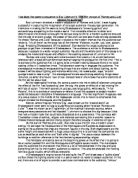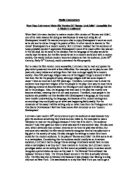As the woman comes to an end, the clip is zoomed to a long shot of two large high buildings. One belongs to the Montague's' and the other to the Capulets' in which there is a statue of Jesus between them. These buildings symbolise wealth and power. They are equal in size and this refers to the statement in the prologue ''each household both alike in dignity''. It shows that both Capulets and Montagues are equal in power. The statue of Jesus represents peace and purity, which is a contrast from the violence and hatred between the families. Then there is a series of newspaper headlines that stress the prologue as the male voice reads. The male voice is serious, deep and solemn. This creates a serious mood for the audience. Luhrmann shows the audience how important these families are to be printed on the newspaper and magazines headline. By having there feud on newspaper and magazines it also shows that their feud is a whole countries problem.
As the man in the background starts to speak, pictures of Romeo and Juliet's fathers are shown next to each other as the operatic music plays in the background. The picture shows that a male is leading the family, during Shakespeare's period men were in charge in society. The music creates a foreboding atmosphere which links to the images shown. The scenes of violence, suicide, riot and death act as a contrast to the ''fair Verona'', (Baz Luhrmann uses violence, riots, deaths… to get the votes of young boys) we expect it to be a very peaceful, charming place. As the man is speaking subtitles are written as well, the texts are written in different fonts and the ''t'' in the phrase ''take their life'' is it forms of a cross. This shows the religious setting and Christ figure it represents, furthermore it is foreshowing the reason why they die since religion is the reason they kill themselves because it was the priests fault for not giving Romeo the letter in person. Also as the man is speaking the characters are shown in actions. For example, as the male voice says ''the faithful mind of these two foes'' we see the two families in their limousines with unhappy faces. This shows enmity and anger between the both families. Baz Luhrmann introduces the actors by writing the characters name and the position they are playing and their position in the family or film instead of writing the actors names. For example, ''Mercutio (Romeo's best friend)'', ''Romeo Montague (Montague’s son)''. Luhrmann has used a very effective and unique method in introducing his characters compared to most films in which the actors are introduced by their real name as well as the character they play. (By showing something new to teenagers it will make them carry on, and Baz Luhrmann has taken advantage of this).
In the ending of the prologue, violent scenes are rapidly shown. During one of the clips, a helicopter flies over Verona giving us very quick views of the city below. This creates a shaky image of the city. The audience experience a feeling of being on board the helicopter looking down. As the montage progresses to the end, the operatic music playing in the background becomes louder until it reaches a climax. Baz Luhrmann has compressed many section of the film in a short space of time. In one of the clips, we also see a little choirboy singing, and then a shot of Juliet as she unveils, dressed in white wedding dress in a church. This little boy signifies innocence and the church suggest religious setting as well as the little boy.
The noisy, riotous gunfire creates a picture of a city in chaos. Police officers armed with guns and fire around the area gives us the impression that Verona is not safe and there is a lot of violence. The fire symbolises anger and hatred, - a theme that runs through the ''Romeo and Juliet'' play. In one of the scenes, as the choirboy opens his mouth to sing, a clip of someone shooting a gun is shown. Baz Luhrmann puts these images together to create a feeling of the choirboy being shot.
As the prologue ends there is a large cross icon in red with white stripes, which becomes smaller and the text ''Romeo and Juliet'' is shown. The cross replaces the word ''and'' in the text. The red colour of the cross symbolises death. Baz Luhrmann has made the prologue exciting by the use of the images, sounds and editing techniques. The images in the prologue are like a trailer of what will happen in the film. (Baz Luhrmann knows that teenagers have a short attention span, so he sets the pace of the prologue at a high speed with excitement. This is another way he gets the appeal of the younger audience).
After the prologue has finished Baz Luhrmann uses a range of camera shots to draw the attention of the audience and to get the audience involved. The most effective of all the shots are the point of view and extreme close up shots. Baz Luhrmann uses the extreme close up shot when he is showing the family arms on the guns, he uses this type of shot because with the extreme close up you could see the difference between the two arms, the Capulet’s arm is gold, red and black where as the Montague’s arm is silver, blue and black these colour differences represent the differences in the families. He also uses the extreme close up when he shows Tyblot’s (Juliet’s cousin) and Benvolio’s (Romeo’s cousin) eyes usually this is used when there is a shootout about to happen therefore Baz Luhrmann is foreshowing that there is going to be a shootout which does happen, furthermore he uses this shot to show the expressions on their faces Tybolt looks confident but Benvolio looks shaken. To get the audience involved with the movie he uses the point of view shot. It is used when two of the Montague boys try to escape the shootout and Tyblot sees them and takes aim, as Tyblot is taking aim it seems like we are taking aim. Finally, Baz Luhrmann also uses the zoom in shot to show how he has transformed the movie, sword in to guns, he does this by zooming in to Benvolio’s guns as he aiming for Abra and the printing on he’s gun says “Sword 9 mm Series S”.
The director doesn’t only use the colours of the family arms to shows the difference in the families, he also uses costumes. As the prologue ends it shows the Montague boys in the car, the boys are all wearing Hawaiian shirts which are undone, (this relates with young boys’ lives) the Hawaiian shirts represent fun and shows that the Monatuges are lively and immature. When the Montague boys get to the fuel station minutes later the Capulets come, the Capultes are wearing black suits this shows that they are serious and mature. This shows that Baz Luhrmann makes the Montagues immature and lively but does the opposite for the Capulets, mature and serious.
In conclusion, Baz Luhrmann has made a mind-blowing, hair gripping, exciting movie and has transformed every part of this play in to a movie, except one - the concept of marriage. He had changed swords to guns, the Prince to a cop. It was acceptable for people to get married at a young age in Shakespeare’s time, because of the low life expectancy. But since we have high life expectancy we intend to get married between the ages of 20-40 years old, yet Baz Luhrmann fails to show this. Baz Luhrmann also fails to appeal to a wider audience - since his main target audience is teenagers.








